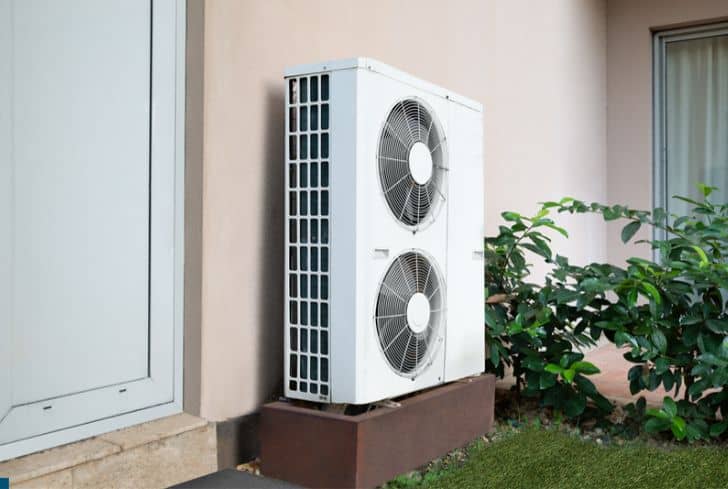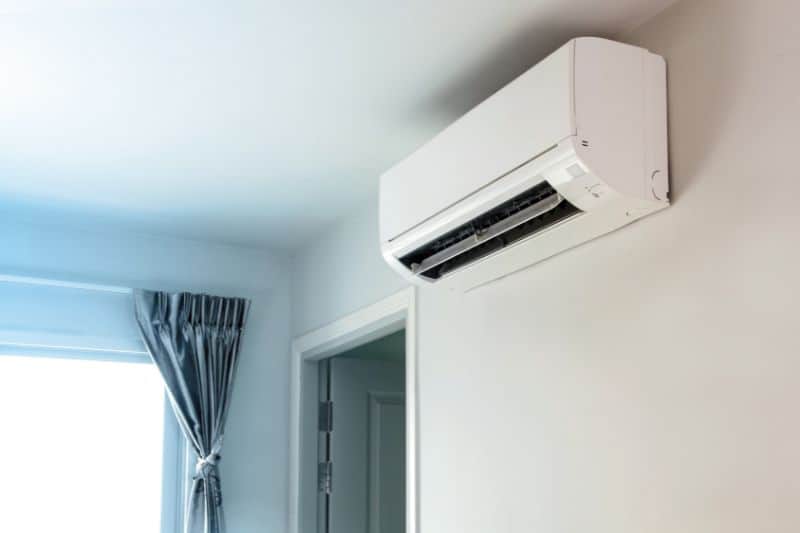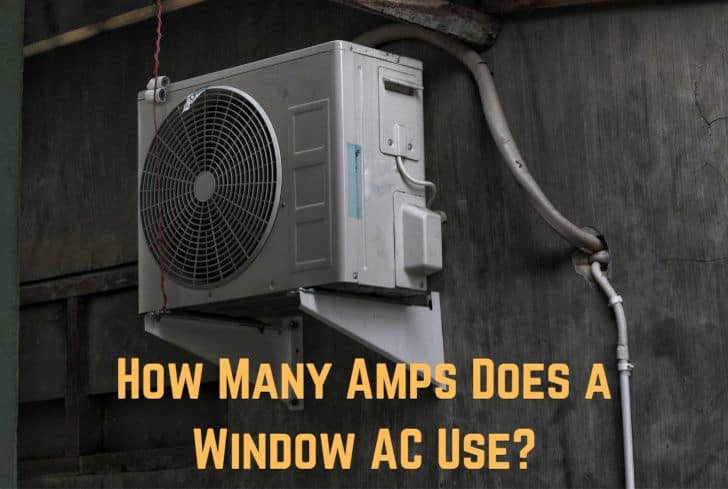A window air conditioner is a great way to give your home extra cooling power during the hot summer months.
But as you equip yourself with one to face the heat, also get ready to tackle the inflated energy bills that will come with it. But just how many amps does a window AC use?
Well, that’s a question that most homeowners are bound to ask, given that air conditioners are some of the energy hogs available in our homes. And today, I’m well-equipped with the answer to that question, so read on!
Read: How Many Amps Does a Dryer Use?
How Many Amps Do Window Air Conditioners Use?
The number of amps a window air conditioner uses depends on your AC system’s exact British Thermal Unit (BTU) rating and its Seasonal Energy Efficiency Ratio (SEER). However, on average, a window air conditioner will pull between 3 and 10 amps of power at 120V, assuming it has the current threshold SEER rating of 13.
Before I proceed, let me begin by explaining some of the terms that just came up in our answer paragraph.
The BTU rating of an air conditioner measures how much heat the system can remove from a room in one hour. So, a higher BTU rating means that the AC can cool a larger space more effectively.
Meanwhile, the SEER, also referred to as EER, denotes how efficiently an air conditioner can operate. The higher the rating, the less power the system will consume for a certain amount of cooling. And currently, the SEER spectrum runs from 13 to 25.
What that means is that 13 is the minimum number required by the US Department of Energy, while 25 is the highest number you’ll find on any air conditioner. The department keeps raising the minimum rating required to make air conditioners more energy efficient.
At the beginning of next year, the new minimum SEER-rating standard is 14 for residential systems in the Northern US and 15 for systems in the Southern US.
Now that we’ve got all that out of the way, let’s go back to our question – How many amps does a window air conditioner use?
As I’ve said, the number of amps an AC uses depends on its BTU and SEER ratings. As for BTUs, window ACs can range anywhere from 5,000 to 12500 and will run just well when connected to a 120-Volt circuit.
So, assuming we go with the current minimum SEER rating of 13, a 5,000 BTU window air conditioner will use around 3.21 Amps, while a 12,500 BTU will draw approximately 10 amps.
Wondering how we’ve gotten these numbers?
No problem.
It’s actually quite a simple 2-step calculation;
STEP 1: Change BTUs to wattage by dividing the BTUs by the SEER rating
That is, Wattage = BTU/SEER
So, for an AC with 5000 BTUs and an SEER rating of 13, we have the following:
Wattage = 5000/13
= 384.6 watts.
For an AC with 12500 BTUs and an SEER rating of 13, we have the following:
Wattage = 12500/13
= 961.5 watts

STEP 2: Convert watts into amps by dividing watts by volts
That is, Amps = Wattage/Volts
For our 5000 BTU AC with an SEER rating of 13 and wattage of 384.6, we have:
Amps = 384.6/120
= 3.21 amps
For our 12500 BTU AC with an SEER rating of 13 and wattage of 961.5, we have:
Amps = 961.5/120
= 8.01 amps
So, window air conditioners with between 5000 BTUs and 12500 BTUs will precisely have the amperage range of 3.21 to 8.01 Amps as long as the SEER rating reads 13 on the appliance label.
However, the amps may go to about 10 if your AC isn’t registering the same level of efficiency it had on its first day. That could be because of the coils getting dirty, or an old or malfunctioning compressor, among other reasons.
How Many Amps Does a 5000 BTU Air Conditioner Use?
A 5000 BTU window air conditioner with a SEER rating of 13 uses around 3.21 Amps at 120 volts. This amperage may differ slightly depending on the energy efficiency and other details of the specific model of your window air conditioner.
A 5000-BTU unit is ideal for up to 150-square-foot rooms and doesn’t require too much power to operate. Actually, it has the lowest power consumption of any window air conditioner on the market.
The system will pull just over 3 amps at 120 volts, which isn’t a whole lot. Considering that most houses have an average of 15-20 amps breakers, it’s more than clear that a 5000 BTU unit isn’t going to pose any problems in this department.
Read: How Many Amps Does a Treadmill Use
How Many Amps Does a 8000 BTU Air Conditioner Use?
An 8000 BTU air conditioner will require about 5.13 amps of power when running efficiently when connected to the standard 120-Volt circuit. Of course, that’s assuming that it has a 13-SEER rating. The amperage could be more if the SEER value is lower and more if the SEER rating denotes greater efficiency than 13.
Assuming that the SEER rating is 17, an 8000-BTU unit with this rating will require 3.92 amps to run. To get this value, follow a similar procedure we provided earlier; convert the BTUs to watts by dividing it with the SEER rating and then divide the wattage by volts.
Even so, as already discussed, keep in mind that whatever value you get with your unit doesn’t have to be what’s actually happening. ACs will, with time, use more amps as they become less efficient, so expect the wattage to be slightly higher than the one you calculated.

How Many Amps Does a 10000 BTU Air Conditioner Use?
A 10000 BTU air conditioner with a SEER rating of 13 will require about 6.41 amps at 120 volts. The higher number of BTUs means that the appliance will use more power, so the amperage will also be higher.
10000 BTU air conditioners are ideal for larger rooms up to 450 square feet. That’s more space than you should use for an 8000-unit, whose perfect room size is about 350 square feet. The larger area means more heat, and a bigger unit will be able to cool the room faster.
And usually, the higher BTUs translate to higher wattage. And assuming you stick to a 120-volt circuit, a more significant wattage number will usually imply higher amperage.
How Many Amps Does a 12000 BTU Air Conditioner Use?
A 12000 BTU air conditioner with a SEER rating of 13 will require about 7.69 amps at 120 volts. So, if this is the unit you’re running in your home, you’ll need a circuit that can handle at least 8 amps without tripping the breaker.
12000 BTUs are recommended for rooms up to 500 square feet. And just so you know, the 12000 is a milestone number for BTUs. That’s because it’s a ton of air conditioning, which is 12000 BTUs.
It might not seem like much, but it makes a whole lot of difference in power consumption. 12000 BTUs are usually the maximum you’ll find in a window air conditioner, so if your room is larger than 500 square feet, consider a different cooling system.
How Many Amps Does a 24,000 BTU Air Conditioner Use?
A 24000 BTU air conditioner, or a 2-ton air conditioner, will pull about 7.69 volts at 240 volts. While the amperage is similar to that of a 12000 BTU unit, the voltage is doubled since this is a much larger unit that needs more power to operate than a smaller one.
24000 BTUs are recommended for rooms up to 1500 square feet. It should do what a 12000-BTU unit can do in half the time. So, it needs that extra power to be able to deliver on its promise.
And for this size of unit, we recommend that you work with a 240-volt circuit unless the manufacturer of your unit states otherwise.
In our calculations, we doubled the voltage, and that’s why the number of amps remained the same. If you use a 120-volt circuit, the amperage will be twice as high (15.38 amps), and that’s something your breaker might not be able to handle.
How Many Amps Does a 3-Ton Air Conditioner Use?
A 13-SEER 3-ton air conditioner, or a 36000 BTU air conditioner, needs about 11.54 amps when connected to a 240-volt circuit. It has an average wattage of 2769 watts, more than any of its predecessors.
If you have a larger 36000 BTU unit, be prepared to handle a higher energy bill. The more the input increases, the more the wattage will grow. And as we stated before, wattage is the ideal measurement unit of how much power your air conditioner is using.

How Many Amps Does a Small Window AC Use?
A small window air conditioner usually uses about 5 amps depending on the voltage, cooling capacity, and of course, the SEER rating. Consider the latest technologies with a higher Seasonal Energy Efficiency Ratio (SEER) for the best efficiency.
The bottom line is, the higher the BTU, the more amps your window air conditioner will use, with all other factors being equal. And the higher the wattage, the higher the energy bill you should expect.
Can You Plug AC Into a Regular Outlet?
Yes, you can plug AC into a regular outlet but only some systems. Ideally, only use a standard 110/120-volt outlet for small units not exceeding 15000 BTUs. And for 15000 BTUs, don’t use any other appliance on the same circuit to avoid overloading.
As for larger units above 15000 BTUs, you’ll need a special 220/240-volt outlet. Never try to operate a 240-volt system on a 110/120-volt outlet, as it will overload the circuit and might cause a fire.
Can You Run an Air Conditioner on a 15-Amp Breaker?
Yes, you can run an air conditioner on a 15-amp breaker as long as it’s a ton or less. Otherwise, the unit will overload the circuit and trip the breaker. If you have a heavier unit, you’ll need to upgrade your breaker to a 20-amp or even a 30-amp circuit.
Usually, the actual amperage the unit is drawing shouldn’t exceed 80% of the breaker rating. For example, if you have a 15-amp breaker, the actual amperage should be at most 12 amps. That’s the standard set by the National Electric Code (NEC).
Sometimes, the manufacturer will recommend the ideal breaker size for your unit. If they do, follow their directions. But generally, going for a larger breaker is always the safest option.
Read: How Many Amps and Watts Does a Vacuum Use
Final Verdict
Air conditioners consume approximately 6% of the power produced in the United States and account for 12 to 27% of energy expenditures in US homes. Even so, with constant upgrades in technology, the efficiency of these units is improving every day.
When buying one, look for the SEER rating since that will give you an insight into how much energy your unit will consume. Higher SEER units may cost more to acquire, but they’ll save you a lot of money in the long run.






